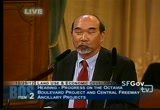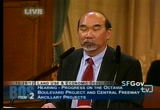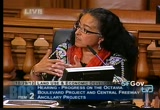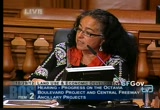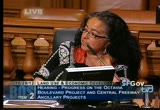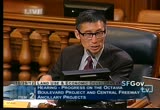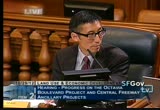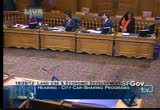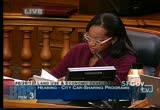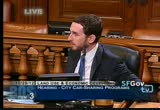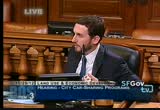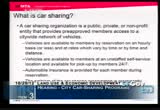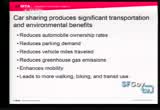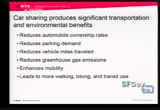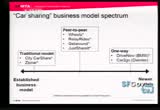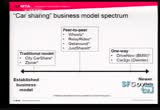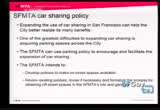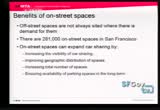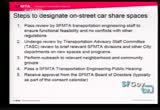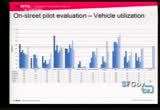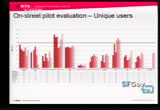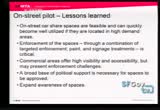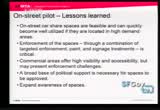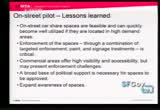tv [untitled] October 29, 2012 2:30pm-3:00pm PDT
2:30 pm
structured in such a way that the affordable housing number will be fixed, at least the 9.8. the structure that will be, as ken explained, that after the additional ancillary improvements and some staffing costs, the affordable housing will be paid out of the next set of proceeds. and then the remaining funds for the van ness improvement. and if there are any funds remaining after that will go for affordable housing. so, i think that the m-o-u will guarantee that, that is at least the amount stated here in the presentation overall. and we will work closely with our fellow departments both oewd and dp w that this m-o-u we all agree to will be adhered to and the monies will be directed towards affordable housing. i did want to state that, you
2:31 pm
know, the role of affordable housing in this neighborhood is not just purchasing the land, but that each individual unit requires the level of subsidy. subsidy probably in the neighborhood of 200,000 a unit and we produced over 300 -- over 3 25 units, which means that the contribution of either redevelopment funds or other funds into the neighborhood to meet the affordable housing goal has been in excess of $32 million in addition to the land purchase. so, the amount of the true up that helps meet those other future funding obligationses that we had to be able to ensure that the affordable housing gets built. * >> thank you. supervisor olague. >> yes, i just want to thank members of the public for coming out today.
2:32 pm
i agree that hayes valley farm is a wonderful use and we've managed to get an extension, i think a six-month extension, at least. and i believe that what we need to engage in is some conversations with mo, with the developers, with the community, and the neighbors to try to come up with a strategy around the timeline for the development and see if there are ways that we can work around the construction and that sort of thing. so, i look forward to having those discussions with members of the public who are here today to see if we can find a way that we can have a simultaneous use. in the past we've looked at legislation around temporary uses, at sites that have been permitted for development. and i think that it's time that
2:33 pm
we revisit that legislation and given the enthusiasm that was seen in the city around urban agriculture and some of these community farms, i think that we really do need to find a way of legislating these temporary uses because right now it it seems a little bit too arbitrary in many ways and we need to have some kind of policy around it. so, i would like to work with mo and planning and members of the community to try to come up with that sort of a scheme. also, i agree that site was blighted for years and the farm has provided [speaker not understood] on the street. all of those things have revitalized the neighborhood and have put a lot of young people to work. so, i look forward to the buchanan mall being used for that hayes valley farm -- some of it being converted there. i believe there are other parts
2:34 pm
of hayes valley that would like to see that type of use. it's a question of finding a site. i think that's one of the limitations of having these cacs developed. many of us worked on the market octavia plan. we approved it when i was still at planning. and we discussed a lot of the issues. and i think now we're starting to see the impact of the densification of the city, of the freeway, and i think there are a lot of unstudied impacts. and i think that the cac being limited to just financial kind of a fiscal sort of role, it's unfortunate in a way because as we're seeing these area plans move forward, we're starting to observe a lot of the issues that are coming up around the impacts around -- as i mentioned, transportation, lack of open space, the densification of this neighborhood. so, a lot of these quality of life issues are really coming
2:35 pm
to -- i think becoming more apparent as we move along. so, we may want to look at kind of that ongoing dialogue that happens with the community around the evolution of some of these area plans because the market octavia is just one of them. eastern neighborhoods is another. there's a lot we still haven't begun to see. they look great on paper and the community is always involved. seems like the conversation stops after the approval and i don't think that's such a good thing. so, again, i just want to encourage us to hopefully mo and the developer, members of the community who are here, can continue to engage in constructive dialogue around, mr. joyce mentioned, around finding ways to continue some of these uses that i think ultimately it will require some kind of legislation that looks at permitted sites and some of the blighting issues and
2:36 pm
definitely issues on open space. the city really is, i think, challenged in many ways around that issue. >> supervisor olague, i just wanted to thank you for bringing this forward. thanks for the presentations from ken rich and also from the mayor's office of housing ultimately and ms. yunga. i did want to say i do support as much money from the true up as we can get for affordable housing development. and i see the hayes valley farm, but also just the transformation of a former freeway area into more livable areas of the octavia boulevard plan. and i wanted to also say that i see the hayes valley farm as a catalyst not only for an area that used to be a freeway on ramp, to more of a greening and an open space. and i am hoping that with the new housing that's developed, that supervisor olague's office and others really work on a
2:37 pm
appropriate alternate site for the farm. i also wanted to say that the urban agriculture alliance has been a product of the hayes valley farm and we're looking at city-wide efforts to make sure that we have urban farms throughout the city, not just in the hayes valley area, but also other parts of the city. also, i'm supportive of the residents from the hayes valley residents to the hayes valley farm leaders that are here today. be sure there is a public open process to discuss this and i know that supervisor olague's office is working hard behind the scenes. and i'm glad to hear there is a six-month extension. but hopefully we can keep active this open space and amazing place that's the hayes valley farm for as long as feasibly possible. i wanted to also say in 1989 during the loma-prieta earthquake, i was right there at the site of the hayes valley farm. for some reason, i must have just gotten off the freeway,
2:38 pm
but i know that i was stranded there. compared to '89 to now it's an amazing place that even my 12-year-old brought a number of her friends to one of the reesev entitle hayes valley farm educational processes. * recent. for the young people that have been empowered through the process of the farm to even others from outside of the neighborhood that come to learn, it's an amazing place that i hope continues to be a catalyst city-wide as well. so, thank you so much for the work, supervisor olague. i'm supportive of the legislation. so, colleagues, this was -- actually, it is an not legislation, just a hearing. >> just a hearing on the parcels. >> thank you, everyone, for the presentations. and, colleagues, can we continue this item to the call of the chair without objection? okay, thank you. thank you, everyone, for coming out. we have one more item that's a great one on car sharing. ms. ausbury, can you please call item number 3?
2:39 pm
>> item number 3, hearing on the status of current city car-sharing programs including: the on-street pilot program, one-way car-sharing programs, and evaluation of strategies to expand car-sharing to the southeastern neighborhoods and other neighborhoods throughout the city that do not currently have a high volume of car-sharing. >> thank you. and the sponsor is supervisor maly a cohen. >> thank you very much. come on, everybody. don't leave. we're going to talk about something just as exciting. come on, car sharing. [laughter] >> i know that affects many of you in hayes valley and octavia boulevard. why do you want to leave? okay. well, supervisor olague, have a seat. [laughter] >> oh, okay, okay. >> [inaudible]. >> okay, yeah, yeah. okay, for the record she said she supports it. although today's item is a hearing, but forgive me. i'm just trying to liven things up a little bit. so, as you know, this is a hearing which means we won't be taking a vote on this particular matter. but thank you everyone who did stay. i introduced this item because
2:40 pm
i've been very encouraged and also honestly a little frustrated by the city's approach to implementing car sharing. car sharing has been incredibly successful in many of our neighborhoods, particularly those with higher density and a population of residents who know how to take advantage of these particular programs. however, in many of our more outlying neighborhoods, which i represent, we haven't seen the same level of success. so, i believe there is a significant room for us to work more collaboratively with departments, car sharing companies, and companies to expand the overall aspects and increase access as well. i'm hoping to accomplish a few things today. three key simple things. first is just a hearing from sfmta folks. thank you for being here with us today. an evaluation of the on-street pilot program. i'm curious to hear about what works and what hasn't worked and want to work through some of the challenges that you've identified.
2:41 pm
second, to discuss with sfmta and the department of the environment, director, thanks for being here, on what your objectives are and strategies are for expanding car sharing into neighborhoods. and third, have a thoughtful discussion with departments and stakeholders hereof a possibility of implementing one-way car sharing programs here in san francisco. so, with that very short introduction, i'd like to bring up sfmta for their presentation. please hold your applause for the end. >> supervisor wiener, did you have a comment? supervisor wiener. >> thank you, and thank you, supervisor cohen, for calling a hearing on this very important subject, specifically car sharing. and i agree that it's extremely important that we provide car-sharing access in all parts of the city.
2:42 pm
and thankfully, particularly for those areas that are poorly served by other forms of transportation such as muni and taxicab service. and we do know that in some areas of the city, in particular districts 10 and 11, muni access is not as good as it is in other parts of the city, and cab access, taxicab access is at times [speaker not understood] nonexistent. so i think it is very important to provide this opportunity. but also backing up and look at this from a systemic perspective, i said this before and i'm going to keep saying it because i think it's true, that if we truly want to be a transit-first city, muni is never going to be enough. even if we had another $100 million a year to invest in making muni the kind of service that we all want it to be in terms of reliability and consistency, it would never meet all of the transportation
2:43 pm
needs of our citizens and our visitors. and if we truly want to see significant movement in terms of reducing the number of private car people make, in terms of getting people able not to have private vehicles to actually give up those vehicles, we have to have, number one, a reliable cab service which right now we don't have in san francisco. and number two, we have to have very, very robust car sharing. and that means traditional car sharing and the newer kinds of car sharing that we're seeing. and we need to make sure that the regulatory scheme actually supports that. and right now we're seeing some car sharing services that are experiencing problems with the california p.u.c. we need to make sure those services have a path to being acknowledged as legal and appropriate. we also need to make sure that we're creating enough spaces for our car sharing service
2:44 pm
providers. we're seeing in some parts of the city with the disappearance of gas stations and disappearance of surface parking lots with some of the most productive ways of providing car sharing spots that it's becoming harder and harder for car sharing companies to actually find spots. and i commend mta for its on-streetcar sharing program. i think that could be terrific. i think we have a ways to go before we can get there. i also have legislation pending to amend the planning code, take away right now the disincentive we have to apply the developers to put adequate car sharing spaces in their developments. we actually make it extremely hard, particularly for smaller development to put car sharing spaces in their buildings. this legislation we're sponsoring will address that problem. i make these remarks to get the broader context and supervisor cohen, thanks again for calling this hearing.
2:45 pm
>> thank you. good afternoon, chairperson mar, members of the committee. i'm mitt rifkin, transportation director. and i concur with you this is an exciting and important topic. i'm sure the reruns of the hearing will be -- will go viral at some point as people catch on to how exciting car sharing can be. i think -- i appreciate your opening remarks because i think they're a good lead-in into car sharing and how it really is an important part of the transit first policy and making that real in san francisco, a policy i'll mind you was adopted by the board of supervisors in 1973. so, i have a brief presentation i'm going to walk through. i am joined by melanie, director of department of environment. there are other representatives from the mta department of environment city administrator's office, car sharing organization. we're certainly working along
2:46 pm
with all of them, working side by side with the department of environment in particular in making sure that the policy is advancing both our transportation and environmental goals, which i believe car sharing is a good example of that. so, if we could go to the presentation, i'm just going to try to walk through briefly some basics to help stimulate the conversation and answer some of the questions that you raised in your opening statement, supervisor cohen. so, car sharing does have a definition currently in the transportation code. this is it. i won't spend time on this, but just want to frame at least from the transportation code, current perspective of what the definition of car sharing is. and this largely is in line with the more traditional car sharing models and this is how the code currently defines it. so, i think you've already started speaking to this, but
2:47 pm
there are significant transportation and environmental benefits from car sharing. perhaps at the top of the list is the potential and i think actuality it has in reducing automobile ownership rates. you may hear stats from others. i've heard that a single car-share vehicle can reduce up to 15 privately owned vehicles. when you think of what that can mean if you multiply it out in a dense city like ours, that could have pretty significant benefit in itself just in terms of needing to be fewer cars in san francisco. because it does take all those cars off the street. it reduces parking demand. it also reduces vehicle miles traveled because the data shows that people who rely on car share to do their auto-oriented travel do much more via transit, via cycling, via the other modes of transportation
2:48 pm
than driving. so, it would be a reduced vmt benefit. and if you put together the reduced number of vehicle miles traveled that car share seems to support, along with the fact that the car share vehicles tend to be greener, that's where you really get some significant environmental benefit in term of reduced greenhouse gas and other emissions. it does, car sharing enhances mobility and contributes to more walking, biking and transit use because people -- and i may be a poster child for this. i am able to live -- my family and i are able to live in san francisco without owning a car because of the existence of car sharing. and, so, because we don't need a car, because of the existence of car sharing, we generally rely on transit. for me, i ride my bike a lot. sometimes we take taxis. we often walk to where we're going. but the fact we don't own a vehicle means we're less inclined to just jump in our vehicles for times when we
2:49 pm
might not otherwise need it. when we do need to drive our own car, we get a car-share vehicle. so, i think if i may be so bold as to say that kind of use epitomizes ways in which car sharing, the existence of car sharing really has very tangible benefits to the transportation system and to the natural environment. so, supervisor wiener made some reference to the fact there are different types of car sharing. this is a spectrum that has the traditional model such as we have here in the city on one end of the spectrum. there are peer-to-peer models that have developed over the last year or so, some of them have been around perhaps a little bit longer. the traditional models have been around for nearly a dozen years in san francisco. the peer-to-peer models where individuals are basically making their cars available for
2:50 pm
others to use. and then the even newer one-way models that are coming into being. we know a lot more about some of the benefits that i just spoke to really pertain to the traditional models because that's what we have understanding and data from. we have much less, if any, on some of these newer models. but it's likely that at least some aspects of the benefits that come from car sharing may be realized by different [speaker not understood] of the traditional models. so, our approach to car sharing reflects the understanding that it does advance the city's transit first policy. it also reflects the fact that it's largely a private sector activity, therefore it's one that's for very small, if any investment from the public sector, we get all those significant transportation and environmental benefits. so, it's something that we want
2:51 pm
to embrace and facilitate. supervisor wiener made reference to the fact that parking is a big issue with regard to car sharing and parking is something that we regulate. so, that's a part of the equation where the sfmta can be helpful in either passively or actively facilitating more car-sharing. and you may hear also from the car-share companies that when they come to speak, that parking is a significant challenge and it's why they often hit roadblocks. so, where we can -- one way that we can best work to facilitate car sharing is by using parking policy to make more parking available for car sharing vehicles which in turn would make more car sharing available to members of the public. so, we are looking at our current parking policies, both on-street and off-street. and i'll speak to some of that
2:52 pm
as we walk through this. in terms of on-street spaces, there are some perhaps unique benefits to on-street spaces. off-street spaces are acquired by or access to them is acquired by the car-share companies based more or lesson the availability of who has space and is willing to lease, or it could be by requirements that are in the planning code. as supervisor wiener mentioned, one of the big down sides is those spaces can go away as they are in certain neighborhoods. we do, however, have a lot of on-street spaces, more than 2 80,000 of them that, while there is some fluctuation in those spaces, generally they're not going to go away. some other benefits of on-street parking for car share vehicles is that it increases the visibility. there's a lot more ability to distribute them equitably and
2:53 pm
where the demands are, that there's a lot more [inaudible] available. and the availability in the long-term because they're not as susceptible of going away as they are lease space in a former garage station site, that they're perhaps more sustainable in the long run. so, for that reason we undertook an on-street car sharing pilot. i guess about a year ago we took exchanges from the fmta board and [speaker not understood] to change divisions 1 and 2 of the transportation code to enable car share parking. and then we worked with the city administrator's office, city car share, which is one of the two traditional car share companies operating in the city, as well as members of the office of the board of supervisors to identify spaces.
2:54 pm
there are other on-street models out there. washington, d.c. and portland being some. our pilot was to see how it would work here. there is a whole process that we, as we do for most uses on the street, took the pilot spaces, too. i won't go through these all, but just to say there was quite a bit of vetting. not originally proposed space made it through. a lot of opportunity for public comment as it relates to san francisco, to make sure that we were being thoughtful in terms of placing these. so, here you can see graphically where we ended up putting spaces. they went in in a few phases, starting in september of last year through february of this year. there were 12 in all scattered somewhat throughout the city. so, one of the goals of the hearing was to discuss results. the two main measures by which
2:55 pm
we evaluated the pilot, the first was vehicle utilization. and this chart shows over the months just the percentage of time the vehicle was in use. you could see it's fairly mixed. there were some that were very heavily used. there were some that were much less used. there were some that started strong and dropped off. that picked up later on. the highest utilization were greenwich, valencia 17th, clay fillmore, [speaker not understood], fourth and clement. so, even in some of those spaces there were some issues, which i'll touch upon some challenges which, again, the purpose of the pilot to identify what some of those would be. the other measure we looked at -- oh, i should mention when you're looking at this chart, you'll see a bar going across. and that was basically a control group of off-street spaces that also i think somewhat comports with industry averages or where we'd want to be. you could see some of them hit
2:56 pm
that bar right off the bat. some of them were approaching it. some were quite a bit away. similarly on this chart, this is looking at unique users, another measure that the industry looks at. generally we found that there was where you had high utilization, you had a number of high users. the purpose of this is to see how broadly based these spaces are being used and whether it's just one or two people using it. >> excuse me for a second. could you once again, can you just define how unique users are identified? what's a unique user or who is a unique user? >> so, it's -- looking at the number of people in every given month relative to the total number of trips. so, if there was a space near me and i was using it 50% of the time, then there would be not so many unique users. so, it's a measure of how many
2:57 pm
different people are accessing that individual vehicle to just two or three people who are using it, or is it wide number or broad number of people. that's what this is measuring. >> [inaudible]. >> sure. so, [speaker not understood]. i think generally what we're pretty happy with the fact i think the general proof of concept, although it has been operating in other places, i think we found that it is certainly feasible. it can quickly become well utilized. as i said, some of them were well utilized from the jump when they went high-demand areas. we did have some issues of enforcement of the spaces, particularly the one in the mission and valencia on 1th. we had a lot of people illegally parking there. we did make some changes to try to reduce that. but it's something -- it's a little bit different issue than we have with off-street spaces.
2:58 pm
so, that's something we need to work upon. there are mitigations such as signage and other things we can do to try to minimize illegal parking of these spaces. * commercial areas are good in terms of visibility and accessability, but also can cause some enforcement challenges. and also going through the process of siting. the spaces, as you know, any discussion of taking the parking space for anything other than general use can be contested. there were some bumps in trying to get some of these, these spots cited. so, we need that process and we need to be able to build the support and demonstrate this one vehicle is taking others off the road, i think it will help that process. and then the last point is i think that for those that didn't do as well, it may be partly attributable at least to inadequate outreach and the
2:59 pm
fact that people didn't know that the space was there and the vehicle was there, maybe didn't know much about car sharing even more generally. i think the places where it did well was often places where there was already strong demand and the vehicle was just filling a gap or filling unmet demand. when going into new places that may not have that kind of latent demand already there, i think there is work to be done by the car share company or by the city, by nonprofit partners to improve -- to get people to understand what car share is and to get to more of a critical mass of car sharing use. so, i think that's an important lesson that we learned. >> so, were there -- was there multiple level approach to sharing this awareness, the car sharing of the pilot program? [speaker not understood] in english? >> i don't know the answer to that. i know someone here can speak to how the outreach was done or the pilot.
189 Views
IN COLLECTIONS
SFGTV: San Francisco Government Television Television Archive
Television Archive  Television Archive News Search Service
Television Archive News Search Service 
Uploaded by TV Archive on

 Live Music Archive
Live Music Archive Librivox Free Audio
Librivox Free Audio Metropolitan Museum
Metropolitan Museum Cleveland Museum of Art
Cleveland Museum of Art Internet Arcade
Internet Arcade Console Living Room
Console Living Room Books to Borrow
Books to Borrow Open Library
Open Library TV News
TV News Understanding 9/11
Understanding 9/11